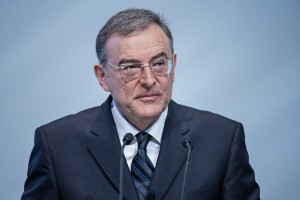
The earth shook slightly on the 13th of May in Munich when Harald Krueger officially took over as Chairman of the Board of Management and Chief Executive Officer at Bayerische Motoren Werke Aktiengesellschaft. Not because this was some unplanned ouster, rather because of the man who was handing over the reins, Norbert Reithofer.

CEO since 2006, under his watch, the company boosted sales by 55%, saw profits rise and embarked on a serious electric car programme. So strong was his tenure that the Quandt family, which controls the company, backed Reithofer moving immediately to the chairman’s role, ignoring the two-year break recommended by the German Corporate Governance Code.
That’s only happened at BMW once before, when Eberhard von Kuenheim moved from CEO to chairman in 1993. He is giving Krueger the keys to a company that is possibly at its zenith.

The question is, where will Krueger drive BMW and more importantly will he be able to do so with Reithofer’s mug staring at him from the rear view mirror? In the premium automotive cage-fight, the 2000s can be described as the BMW decade. They began the new millennium on the back foot, still reeling from the aftershocks of the Rover misadventure. While the wounds from their foray across the Channel were deep, so were the lessons learnt. The company came to realise that although moving up the value chain was a natural evolution of business, going the other way, was not as easy.
BMW had been a premium manufacturer and trying to play in a non-premium segment proved disastrous (let’s not even start to get into the “Englishman taking orders from Germans” narrative). It was at this point in time that the company went for broke and placed all its weisswurst into the “Premium” pot. With their eyes firmly fixed on taking over the No.1 mantle, the company set out on an ambitious programme to dethrone the incumbents from Stuttgart, at the time a quest of Quixotic proportions.

A radical departure in styling, led by enfant terrible design head, Chris Bangle, brought a slew of changes that were to say the least, polarizing. So great was their zeal for change, BMW boss Helmut Panke once admitted that BMWs all looked like “different cuts of the same sausage”. Starting with the introduction of the “Bangle butt” 7-series – that changed. Where the BMWs of yore had pleasant aesthetics and understated style, the new BMWs would not have been out-of-place in a Hot Wheels catalogue. And while the jury may have been out on design, the sales numbers starting chalking up. In 2005, BMW became No.1 in the premium segment and have stayed there ever since.

Today, it would seem that the tide is turning. For the first time in a decade at this year’s BMW Annual Press Conference, journalists felt the icy wind of defensiveness as Reithofer’s said, “Volume is not everything and maintaining the same level of growth is not everything.”. A big difference from events of the past when we were always assured of new sales highs and that all would be well in terms of volume and profit.
On the design front, the company seems to have hit a wet patch. While there have been some brilliant show-stealers like the 4-Series Coupe, the general consensus has been that BMWs now look slightly boring and a tad familiar. The company has also had to eat humble “kugen” after “going turbo” and the cardinal sin, front-wheel-drive.

Previously quite openly disdainful of the two technologies, the company often claimed superiority by offering an “authentic” driving experience. And while innovative and ambitious, the design changes of the early millennium were always marked by a strict adherence to brand values, engineering and heritage. In any case, the company has done a good job with some clever “reverse engineering” and slick marketing to stretch the brand to new levels of elasticity.
The first test facing Krueger will be to emerge from the shadows of the predecessor who will be watching over his shoulder. Reithofer’s shift to chairman could make it harder for Krueger — at 49, the youngest chief of any major car manufacturer — to break with his predecessor’s strategy.
 While BMW sits atop the luxury-car market, the industry is changing. For Krueger, the risk is that there may be nowhere to go but down because of BMW’s shrinking leadership. That puts the new CEO in a position of determining how to proceed with expensive projects initiated by his predecessor. This includes the electric-powered “i” sub-brand, which consists of the flashy i8 sports car and the i3 compact. BMW said in January that cheap gasoline makes electric models even tougher to sell. He’ll also need to decide how to proceed with using lightweight but pricey carbon fibre, a material BMW pioneered for mass production.
While BMW sits atop the luxury-car market, the industry is changing. For Krueger, the risk is that there may be nowhere to go but down because of BMW’s shrinking leadership. That puts the new CEO in a position of determining how to proceed with expensive projects initiated by his predecessor. This includes the electric-powered “i” sub-brand, which consists of the flashy i8 sports car and the i3 compact. BMW said in January that cheap gasoline makes electric models even tougher to sell. He’ll also need to decide how to proceed with using lightweight but pricey carbon fibre, a material BMW pioneered for mass production.

BMW insiders say Krueger is a charismatic consensus-builder, and that’s how he got the role. He is said to be very approachable and is more international in his outlook. Where Reithofer made his presence known, Krueger is said to be far more subtle. Influential business publication Manager Magazin dubbed him the “master of the noiseless ascent.” After stints in Germany, the U.S. and U.K., Krueger joined BMW’s management board in 2008 where he was first responsible for personnel, and later for the Mini brand as well as production. In any case, Krueger has his work cut out for him. After a decade of non-stop Oom-Pa-Pa, can the weissbier keep flowing?